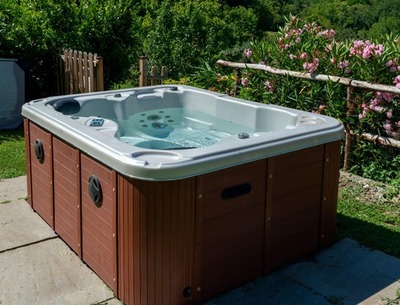
A hot tub is a huge investment you want to enjoy as long as possible. However, learning the intricacies of hot tub care for beginners can be overwhelming.
One good place to start is knowing how to sanitize your hot tub and what sanitizers to use.
Like swimming pools, hot tubs can harbor viruses, bacteria, fungi, and other contaminants that may cause skin irritation and infection. Knowing this, you won’t want to invite your friends or family for a cozy dip in an unsanitized spa!
Chlorine and bromine are the two most common sanitizers for eliminating harmful pollutants. They ensure safe and hygienic bathing so you can enjoy a well-deserved downtime in your jacuzzi.
This guide will share everything you should know about chlorine vs bromine hot tub care. We’ll discuss their pros and cons, and which spa sanitizer is right for you.
Chlorine For Hot Tubs

Chlorine is a chemical most commonly used to disinfect drinking water and swimming pools. When added to your spa water, chlorine kills most bacteria, including E. coli, salmonella, and fungi that may otherwise cause diarrhea and swimmer's ears.
How Does Chlorine Work as a Sanitizer?
While a heavy lifter among disinfectants, chlorine cleans your comfort bath through a rather simple chemical reaction.
As you pour the chlorine solution into your hot tub water, it breaks into several chemicals, including hypochlorite ions (OCI) and hypochlorous acid (HOCI).
These agents kill microorganisms by invading their cell walls and destroying their insides, rendering them harmless and oxidized.
Although they come from the same chlorine substance, HOCI and OCI differ in the speed at which they kill pathogens. Hypochlorite ions can take several minutes, while hypochlorous acid eliminates germs in several seconds.
Ideally, you want your water’s pH level at 7 or 8 for the HOCI and OCI chemicals to eliminate pathogens faster.
After cleaning up pathogens, the chlorine agents combine with other compounds or disperse into singular atoms. Either way, it makes the sanitizing chemicals harmless and the water safe for consumption and bathing.
How to Use Chlorine to Sanitize a Hot Tub?
To keep your hot tub clean and ready for that spontaneous desire to soak, you want to maintain its chlorine levels at 3 ppm (parts per million). You can measure this using ready-made testing strips.
However, if you’re a first-time spa owner, it’s easy to overdose your hot tub with too much sanitizer. The size of your spa and your starting chlorine levels are important considerations when deciding the amount of chlorine.
The general rule is to mix 1/2 teaspoon of chlorine granules weekly for every 100 gallons of hot tub water. Standard-sized hot tubs typically hold 300 to 450 gallons of water and need 1 1/2 to 2 1/4 teaspoons of chlorine granules.
For severe contamination cases or when chlorine ppm is below one, your hot tub may require a higher dosage of sanitizing chemicals. You want to “superchlorinate” the water by mixing one teaspoon of chlorine granules for every 100 gallons of spa water.
Do these while keeping an eye on the chlorine levels, as anything above 5 ppm can cause skin and eye irritation. Not to mention it also corrodes hot tub components.
Sunlight also speeds up chlorine’s breaking-down process so you may need more chlorine for an outdoor hot tub.
Types of Chlorine For Hot Tub Treatment
Experts employ several types of chlorine to balance hot tub water chemistry. Which chlorine you need depends on availability, storage options, and pH requirements. Here are some common chlorine types used for hot tubs:
Chlorine Granules
Chlorine is seldom sold in its pure form. Rather, they’re often distributed in granules composed of calcium hypochlorite and other chemicals to stabilize the sanitizer for safe handling.
Chlorine granules are often considered the best chlorine for hot tubs. You can pour the granules directly into your hot tub water for weekly maintenance. They dissolve fast and are straightforward to use for first-time spa owners.
Chlorine Tablets
These are solidified tablets made of trichloro-s-triazinetrione, containing around 90% chlorine. Unlike granules, chlorine tablets dissolve slowly and are mainly added to the floating dispenser or chlorinator.
Applied correctly, chlorine tablets can be a convenient way to keep your spa water in pristine condition. A piece or two of a 1-inch-sized tablet can typically disinfect 400 to 500 gallons of hot tub water.
Liquid Chlorine
Like granules, liquid chlorine can be poured directly into your tub. However, it’s a concentrated chlorine sanitizer, so you may want to measure the amounts correctly to prevent chlorine vapors from forming.
Liquid chlorine can be a great way to disinfect your hot tubs quickly. Generally, one or two ounces of this solution is enough to decontaminate most standard-sized spas.
Chlorine Shock
Chlorine shock contains sodium dichlor, although at a lower percentage than granules. But it also has an oxidizer, which is why it’s mainly used for deep cleaning severely contaminated hot tub water.
Shocking removes algae, bacteria, and germs, preventing further growth or invasion. Most experts recommended shocking your hot tub at least once every week—more often if it’s frequently used.
Bromine For Hot Tubs

Bromine and chlorine are both halogens and are closely related chemically. As a result, they can be used interchangeably to sanitize drinking or bathing water. However, there are some key differences.
How Does Bromine Work as a Sanitizer?
One of the biggest differences between bromine and chlorine is how they eliminate contaminants and pathogens.
Unlike chlorine, which oxidizes germs and bacteria, bromine ionizes them, breaking up the chemical bonds of the pollutants and killing them. It also remains active and working even after the bromine merges with other particles.
Chlorine is more reactive than bromine, which means it’s slower to take effect. It also breaks down faster when exposed to sunlight, so it’s important to keep the tub covered when disinfecting with bromine
.Slower doesn’t mean less effective, though. This halogen can annihilate harmful pathogens like E. coli, Pseudomonas, and other waterborne viruses. It also oxidizes unwanted organics in the water.
Bromine leaves behind waste products called bromamines. These remnants can reduce bromine's effectiveness over time. Shocking is one way to eliminate bromamines and improve water treatment.
How to Use Bromine to Sanitize a Hot Tub?
Bromine needs plenty of time to build up in the water, and raising its levels from a low starting point can be difficult.
If your hot tub is new and filled with fresh water, start with a bromine booster (sodium bromide) to kickstart the sanitization, before adding an oxidizer (non-chlorine shock) to activate the bromine chemical.
Once that’s done, you can immediately switch to bromine granules or tablets to regulate your hot tub water’s chemistry.
Check the bromine levels using a testing strip. Unlike chlorine, you want it slightly higher at 3 to 5 ppm, with 5 ppm being the most ideal. Lower than 3 ppm means the water could be severely contaminated.
Additionally, you may need to adjust your water’s pH level when sanitizing with bromine. While it's effective in a wide pH range, we highly recommend maintaining a pH between 7.2 and 7.8 to boost its effectiveness.
Depending on how much and how many use your hot tub, you’ll typically add bromine once every few days to keep the water safe and clean.
Types of Bromine For Hot Tub Treatment
Bromine usually comes in tablets and granules. You can choose between these two depending on which suits your needs.
Spa Bromine Tablets
Bromine tablets work similarly to chlorine tablets. Instead of melting in the water immediately, the sanitizer slowly dissolves into the water over time. Bromine tablets for hot tubs take up to a week to melt away.
You place these tablets into the floating dispenser or tablet feeder. Generally, it usually takes three to five tablets of bromine to disinfect a hot tub for an entire week.
Hot Tub Bromine Granules
Bromine granules contain 10% to 20% sodium bromide and dichlor, also found in chlorine granules. You use it by pouring the granules into the spa water and giving it several minutes to disperse.
If you choose this sanitizer, ensure you buy a brand that’s specifically made for hot tub maintenance. Always have a testing kit nearby to measure bromine levels and adjust accordingly.
Chlorine vs Bromine - Main Differences
Now you know how chlorine and bromine, the top two options for hot tub sanitizers, work to clean your bathing water. It’s time to explore what sets them apart. Here are the key differences between these two cleaning agents.
Cost and Availability
Many prefer chlorine to sanitize hot tubs and pools because it’s easier to find. It’s also significantly cheaper and more effective in smaller doses than bromine.
You’ll need larger amounts of bromine to achieve the same results as chlorine. However, you also won’t need to sanitize as often.
Ionizers vs oxidizers
While different in how they handle contaminants, both sanitizers leave behind waste products in your spa water.
Chlorine oxidation produces chloramines or “used chlorine.” These particles are the culprit behind the distinctive smell that may cling to your hot tub after cleanup. The more chloramines, the less effective chlorine becomes in disinfecting.
On the other hand, the bromamines left after ionization are less obnoxious. They don’t emit a foul smell, though your hot tub may require shocking now and then.
Side Effects
Chlorine may be the more potent sanitizer, but it doesn’t come without any downside. Too much of this chemical could lead to skin and eye irritations. While slim, there’s also the chance of toxic chlorine vapors.
For people with skin issues, bromine is less harsh and gentler on the skin and eyes, even when used liberally.
A quick reminder:
Never mix chlorine and bromine in the same hot tub. When combined, these chemicals produce bromine and chlorine gas. These fumes are toxic and are highly hazardous to your health.
Effectiveness and Stability
Chemically speaking, chlorine exceeds bromine in sanitizing potency. It eliminates contaminants and pathogens faster and more convenient for unplanned hot tub dips.
Bromine is far more stable and effective in higher pH levels and temperatures. The chemical lasts and works longer, ridding your hot tub of bacteria for longer periods. If you use your hot tub regularly, opting for bromine means less time sanitizing your bath water.
Bromine or Chlorine: Choosing the Best Sanitizer For Your Hot Tub Care

So, which sanitizer is best for hot tub and spa water care? The honest answer is it depends.
Both chlorine and bromine can work wonders at keeping your prized hot tub clean and ready for dipping. So, choose wisely based on your unique needs.
Chlorine cleans faster, cheaper, and widely available. But it also has a few hiccups, including its odor and minimal health risks.
Bromine works slower but with a lasting sanitizing effect. It’s also more stable and milder than chlorine. Its few drawbacks are that it’s pricier and more complex to use.
Whichever way you go, do it alongside proper hot tub care procedures and you can enjoy a safe and satisfying soak for years to come!
FAQs
Why Do Hot Tubs Have So Many Bacteria?
When hot tubs are used frequently, especially by multiple people, the water gets contaminated with bacteria, fungi, viruses, and pathogens. These contaminants may come from human sweat, urine, and wind-blown debris.
How Often Should I Sanitize My Hot Tub?
Regular sanitization is one of the main pillars of hot tub maintenance. Drop three to five jacuzzi bromine tablets into your chlorinator every other week to keep contaminants away. If you’re using spa chlorine, increase the frequency to every two or three days.
How Often Should I Change My Hot Tub Water?
Experts advise hot tub owners to change the water once every three months. However, this can vary on the bathing habits, water quality, and upkeep procedures. Your filter may also need regular monthly cleaning.

